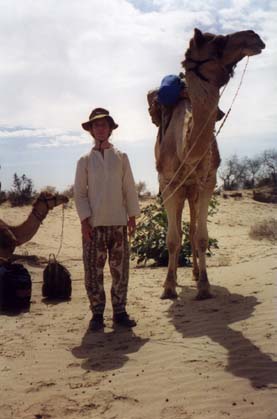|
Camel Contact, Part 1 March 7th, dawn of a three-day camel safari that most visitors to Jaisalmer find themselves taking. Up early and out to meet the those whose paths have crossed, the safari folk: Ginny's an easy-going British woman I met on the bus from Jodhpur to Jaisalmer. Brane's the tall, angular Slovenian I first met back in Udaipur. His head is shaved smooth and his eyes pierce you with an understanding gaze. Jason's a boisterous, stocky, friendly guy from Vancouver, British Columbia. There's a shy, quiet Swiss guy named Marcus, and Lucas is a tall guy from Holland. A cup of chai warms our insides as the sky lightens. Pradeep, the safari organizer, bids us farewell and we cram into a jeep for the 35-km. trip out to the desert, the camels and breakfast. The sun rises É we plug on south along a "main" road, to a smaller road, to a dirt road, to barely any sign of a road at all. When we finally park, the jeep driver honks a few times. Forms materialize from the bushes and the desert sand like chameleons showing their colors. As we munch on a breakfast of alternately burnt or undercooked white bread, honey, jam and chai, we have an opportunity to meet the three Muslim guides and seven camels with whom we will be wandering the desert for the next three days. As a way of introducing itself, one of the camels emits a deep intestinal gurgling sound. A bulging pinkish sac sloshes out of its mouth. It is, in fact, a juicy red organ. Camels have the ability to expel a digestive organ that sits in their neck out of their mouth. It dangles to one side, quivering like Jell-O, then recedes into the depths of their prehistoric frame. In a group, one organ expulsion often excites the other camels to similar feats. The intestinal call and response crescendos to a frothy peak, then bubbles out. Today's group gastronomic eruptions seem inspired beyond the norm.
Click here to hear these camel organ expulsions, if you dare. A camel's face has such an interesting expression, with thick eyebrows and lips that jut out like a pouting child. Certainly a beast with personality.
Notice the camel's disdain for photos. I fall sick to my stomach, feverish in the relentless sun and possibly influenced by the camels' intestinal upheaval. Bouncing up and down on a camel's back in the hot sun certainly doesn't improve my state. It's difficult to stop a camel if you don't know how. I stop once, and the safari waits. When we move on, the bouncing of the camel is like a sun-stroked, choppy sea. I manage to stop again by guiding my perpetually ravenous camel to a bush to munch on. I shout for the others to stop, but they don't hear me. Out in the middle of the desert, alone except for a hungry camel, screaming in vain. Finally a head appears on the horizon, one of the guides taking pity on me. We walk to a village where the others have stopped for lunch. I stagger there weakly and immediately lie down under a tree. Black tea with sugar revives me a bit. People come from a nearby village, and one proffers a black chunk, like a small stone, which he says will help soothe my stomach. It turns out it's a tiny dose of opium, used in small quantities to calm the stomach, or lull the baby to sleep. In taste, texture and by sight it resembles a hardened chunk of brown sugar; its effects are subtle. A taste of somnambulous nectar. I rest, then feeling some of my strength returning, do a seated magic show for everyone. Magic is a universal language; the feeling it leaves is like falling and being caught, a break from reality. I'm always amazed by magic's ability to break down walls and start conversation. Sakria Khan, one of our guides, discovers my portable tape recorder, and when he realizes it can record his voice, he launches into a passionate, if not entirely on key, song.
Click here to hear Sakria Khan and friends, Singing to the sand and the sunset and the cacti, Singing to the cacti and the camels and the sand ... The safari guides run through their song repertoire as they bob along together on the back of a single camel, keeping the caravan together. We set off again across a mix of sand, stone, bushes, trees, poisonous purple Shiva flowers, open desert, farm plots, and baby lambs with bells tinkling around their necks.
Just before sunset we reach sand dunes, where we stop for the night. I lie down in the soft sand and watch the sunset. The sky is the clearest, most smog-free sky I've seen in India. I feel connected to Earth, stable, relaxed and, thankfully, recovering from the day's illness. Our guides hobble the more mischievous camels, which involves tying their front legs together, and sometimes their back legs one to the other as well. A hobbled camel with wanderlust in its veins can hop kangaroo-style with remarkable speed, but it's a pitiful, caged sight. The guides cook dinner. Around the campfire after dinner, children come from a village hidden nearby - the Thar desert is surprisingly well-populated. They want a magic show, so I give one in which I improvise with a vanishing silk and enchanted lights that trace forms in the night sky like fireflies. I sleep on top of a sand dune, stirring from dreams after the bright moon has set, leaving a clear view of millions of stars. The creamy swath of the Milky Way stretches from horizon to horizon. Asleep and then awake, and the eastern sky glows pink. |



